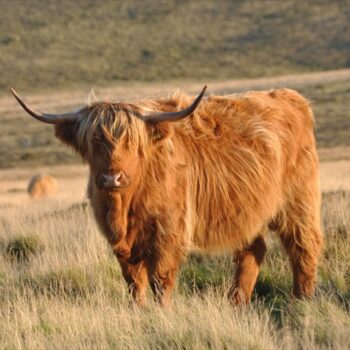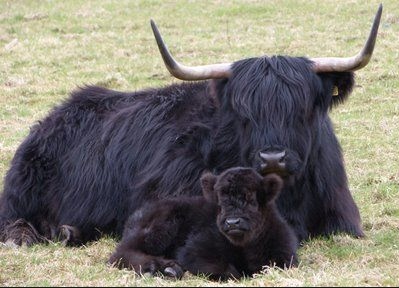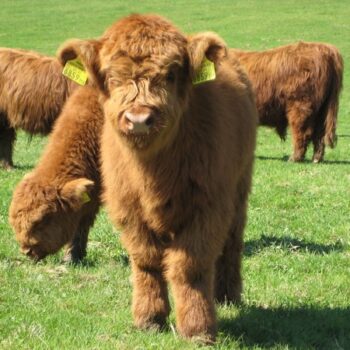Highland Cows (and 9 fun facts you need to know about these legen-dairy beasts!)
Highland cows are often known as the gentle giants of Scotland. With their long horns, and flowing red locks, these iconic beasts are easily recognised, but how much do you really know about them? This article aims to explore the magnificent creatures in more detail, and by the end, we are sure you will fall as udder-ly in love with them as we have!
Fun Highland Cow fact 1: The Highland Cow is the oldest registered breed of cattle in the world! Their presence was first recorded in the Outer Hebrides in the 6th Century!
How to recognise Scottish Highland Cattle (aka fluffy cows)

They have distinctive horns and long, wavy, woolly coats often described as fluffy. They can be a range of colours, including red, ginger, black, dun, yellow, white, grey, tan, silver and brindle. Highland cows are raised primarily for their meat, which is growing in popularity due to being lower in cholesterol than other forms of beef.
These cattle are a hardy breed, designed to withstand the conditions in the Scottish Highlands. Their long hair is actually an unusual double coat of hair- on the outside is the oily outer hair, the longest of any cattle breed, and it is covering a downy undercoat underneath. The bulls can way up to a whopping 800kg, and the cows up to 500kg, and their milk generally has a very high butterfat content.
Their distinctive long hair keeps them warm in winter, overs protection from the brush and undergrowth, protects their eyes from flies and it contributes to their stunning appearance which makes them so popular. The hair gets shorter in Summer and is not as long when they are bred in Southern climates. Having such long hair also means that they do not need to store the waste fat you find in some other breeds of cattle.
Fun fact 2: Nobody is quite sure if these cows can actually see where they are going! But whether they have super-vision or heightened other senses they certainly manage to find what they are looking for, even with that long fringe (known as a ‘dossan’) blocking the way!
The history of Highland Cows

During the 18th century thousands and thousands of highland cattle grazed upon the forests and hills of Strathspey, and in the Summer they were even taken up into the high Corries. Herdsmen stayed in temporary buildings in the hills (called shielings) to look after them, whilst their relatives had to stay at home to gather crops for their winter feeds.
When they were fattened enough for market the cattle were driven along trackways through the mountains, called drove roads. They walked just a few miles each day staying in regular stances every night where the animals could graze and stay safe.
The markets were held in places like Falkirk, Crieff & Carlisle and buyers came all the way from England to pay good prices for what they called high-quality ‘Scotch runts’. So-called because the Highland cattle were smaller. At one market in the early 1800s some £30,000 changed hands, an absolute fortune by today’s standards!
They were so popular, that cattle thieving was common and individuals could apply for a commission to set up an official Watch, which farmers would pay to retrieve stolen stock. Rob Roy MacGregor operated a Watch and was also a cattle dealer, drover and sometimes – thief. If you are interested in Rob Roy MacGregor then you can find out more about him HERE.
While Highland Cows today are mostly recognised for their distinctive red coats, once upon a time they were predominately black.
Fun fact 3: Queen Victoria is said to have commented on a trip to the Highlands that she preferred the red coloured cattle and in an effort to please the Queen, this resulted in selective breeding of the reddish colour that we see most often today and the black colour gradually declining over time.Originally, the breed was divided into two classes, the West Highlands or Kyloe, and the Highlander.
Originally, the breed was divided into two classes, the West Highlands or Kyloe, and the Highlander.
The Kyloes were raised on the western islands of Scotland and tended to be of a smaller size. They had a higher percentage of black and brindled cattle than the mainland Highlanders. The size difference was probably due more to the severe climate and limited rations that the island cattle were subjected to, rather than to any genetic variation between the classes. Today all members of the breed are just called Highland.
Where do Highland Cows live?
They originated in the Highlands and the Outer Hebrides islands of Scotland as early as the 6th century. These days they can also be found across the south of Scotland, in other parts of Europe, as well as in Australia and North and South America too. Highland Cattle can even be found foraging 10,000 feet up in the Andes!
Fun fact 4: If you are seeking the Highland Cow whilst visiting their country of origin, you may find yourself with more success if you ask the locals to point you in the direction of the “Hairy Coos”, as they are locally and affectionately known.
Often these striking beasts can be spotted in fields along the roadside, all over the Highlands, especially in places like the Cairngorms National Park or roaming free on the road itself across the North West.
What are Highland Cows used for?
Highland Cow Milk
Highland cows can be milked on a small scale, they will never make as much milk as a production milk cow, but enough for personal use, one cow can produce on average around 2 gallons per day. Their milk has an extremely high butterfat content, up to 10%, which some farmers may find appealing, but others have stated is a required taste! The Highland has much smaller teats than other breeds of cattle.
Highland Cattle Meat
Breeding for meat is why a lot of farmers keep the Hairy Coos. Their meat is lean, but well marbled, normally rated as premium beef. Pure Highland beef comes at a price, pure Highland beef commands a premium price due to its fine texture, succulent flavour and high protein content. Numerous tests in Scotland have shown that Highland Cattle meat is lower in both fat and cholesterol than even chicken! It also is high in Iron.
Fun fact 5: The Queen has a herd of Highland Cattle and it is rumoured to be the only kind of beef she will eat!
Scotch beef farming is nothing like intensive cattle farming, the system prioritises the welfare and well-being of it’s animals. Due to the grazing land being often unsuitable for growing alternative foods, not to mention the low temperature and high rainfall, Highland Cattle farming is considered to be highly environmentally sustainable.
Cross-breeding Highland Cows
The market for high-quality meat is declining as many people are searching for lower-cost options. To address this decline in popularity, it is becoming a common practice to breed Highland “suckler” cows with other breeds, such as a Shorthorn or Limousin bull. This creates a crossbred beef calf that has the tender beef of its mother but at a more competitive market price.
These crossbred beef suckler cows will still inherit the hardiness, thrift and fantastic mothering capabilities of their Highland mothers, but are more commercially friendly. They can then be further cross-bred with a modern beef bull such as a Limousin or a Charolair to still produce good quality beef.
Showing Highland Cows

For showing purposes, Highland cattle can be sometimes groomed with oils and conditioners to give the coats a fluffy appearance, similar to that of their calves, leading to the affectionate nickname of ‘fluffy cows’.
The breed standards guidelines, which are used to ensure that the animals produced by a breeder are of the highest standard, includes direction on how to judge the animals in four main areas: the head, the neck, the back and body, and the hair. Criteria looked for includes natural horns, being wide between the eyes, short and straight legs and wavy hair. Find out more at the Highland Cattle Society.
Fun fact 6: The most noticeable difference between the 2 sexes is their horns. A bull’s horns often grow forwards or even slightly downwards and have a much wider base, whereas a cow’s face upwards and are longer and finer at the tip than a bull’s horns.
Are Highland Cows Friendly?
Short answer- yes! These fantastic beasts have a reputation for their fantastic temperament, not a moo-dy cow in sight!
They are known for being a very docile animal, never showing any aggression and are very low stress to keep and manage. Within their herds they have a great understanding of their own social hierarchy and never fight. They also enjoy the company of humans, often approaching walkers seeking affection.
They have even been kept as pets! Highlanders have been living alongside man for thousands of years, with written record as far back as the year 1200-AD, and archeological finds that take them back to 1200-BC. In the earlier days, in winter the cows would come into the home and their body heat helped warm the home. This had the added benefit of also keeping others from stealing them.
Fun fact 7: The collective name for a group of cows is usually a herd. However, a group of Highland cattle is known as a ‘fold’ – named after the open shelters they can be kept in over winter.
What do Highland Cows eat?
It is possible to have entirely grass-fed Highlands, they will survive on roughage and poor grazing including brush if necessary. Breeders however will often supplement with good hay, straw, green feed or silage in the winter, or some have their own unique diets for their herd which they swear by, from strictly grass and hay diets, to cereal grains, or barley, wheat or corn silage, or even peas and turnips! Extra mineral supplements may be used by farmers, especially for pregnant cows and mothers with calves still with them.
In general though as long as there is access to plenty of fresh water, these beasts will thrive. Highland Cattle are fantastic scavengers; they will eat almost anything if it has food value, including poison ivy, honeysuckle vines, tree leaves they can reach and cedar trees. In fact, when hungry they will clean entire woods up as high as they can reach. These wonderful hardy animals have the ability to thrive in poor pastures that other cattle would surely die in.
Fun Fact 8: You might have heard the term ‘arriving in droves’ before? This may be because Highland farmers would move their cattle along tracks known as ‘drove roads’. The infamous Rob Roy MacGregor was (amongst other things!) a drover.
Highland Cattle Calves
The only time it is generally not regarded as a good idea to approach the Highland Cow, is when she is with her calf. These gorgeous animals are known for being fantastic mothers and could be defensive and protective over their young.
Fun fact 9: Mother Highlands are known for often breeding beyond the age of 18 and raising 15 or more calves in their lifetime! Impressive, hey? Rather them than me!
They calve alone with no help what so ever, generally giving birth to small calves, averaging 50-75 pounds, but they do grow very quickly once born. The calves moderate bone structure and slim conformation along with the cow’s wide pelvic reduce calving problems such as caesarean and prolapse.
It is not only the mothers that take good care of their calves and will protect them from predators- the whole fold will prioritise and protect the calves. The calves are famously fluffy and adorable.
Where to see Highland Cows in Scotland
Highland cows, also known as Highland cattle, are a distinctive and iconic breed of cattle in Scotland. You can often spot them in various locations throughout Scotland, offering visitors a unique and charming experience. Here are a few great locations:
Rannoch Moor, Perth and Kinross
Visitor Experience: Rannoch Moor is a vast and picturesque wilderness in the Scottish Highlands. Visitors can often spot Highland cows grazing in the moorland as they explore the area. It’s a stunning backdrop for photography and a peaceful place to observe these gentle giants in their natural habitat.
Isle of Skye, Inner Hebrides
Visitor Experience: The Isle of Skye is known for its breathtaking landscapes, and Highland cows are a common sight here. Tourists can find these shaggy cattle while hiking through the island’s scenic countryside or driving along the coastal roads. The dramatic scenery of Skye adds to the overall experience.
Glen Nevis, Fort William
Visitor Experience: Glen Nevis, near Fort William, is a popular location for outdoor enthusiasts and hikers. Highland cows often graze in the glen, offering hikers a chance to encounter them while exploring the area. The towering peaks of Ben Nevis and the surrounding mountains provide a stunning backdrop.
Loch Lomond and The Trossachs National Park, Stirling
Visitor Experience: Scotland’s first national park, Loch Lomond and The Trossachs, is a haven for nature lovers. Highland cows can frequently be seen while exploring the park’s woodlands and meadows. It’s a great place to enjoy hiking, picnicking, and wildlife spotting.
Kilmahog, near Callander
Visitor Experience: Kilmahog is a small hamlet located near Callander in the Trossachs. It’s home to a popular tourist stop where you can often find Highland cows up close. Visitors can pet and feed these gentle creatures while learning about their history and significance in Scottish culture.
Aberdeen Highland Cattle Market, Aberdeen
Visitor Experience: If you’re interested in seeing Highland cows in a more structured setting, consider visiting the Aberdeen Highland Cattle Market. Here, you can witness these majestic animals being bought and sold. It provides insight into their role in the agricultural industry and is an educational experience for visitors.
Highland Wildlife Park, Kingussie
Visitor Experience: For a controlled environment where you can observe Highland cows and other Scottish wildlife, the Highland Wildlife Park in Kingussie is a fantastic option. It offers guided tours and the opportunity to see these iconic animals up close while learning about their conservation.
Scottish Highland Festivals and Events
Visitor Experience: Throughout the year, various Scottish Highland festivals and events feature Highland cows as part of their attractions. These events showcase the cultural significance of Highland cattle and often include opportunities to interact with them.
When visiting these locations, it’s important to remember that Highland cows are gentle creatures, but it’s essential to observe them from a respectful distance and not disturb them. Enjoy the unique experience of seeing these magnificent animals in their natural or controlled environments while savoring the beauty of the Scottish landscapes they call home.
So there you have it…
Maybe next time you stumble across one of these photogenic animals with their just-jumped-out-of-bed hairstyles, you will find yourself looking past their beauty and remembering all the other reasons for their ‘super-coo’ status!
Highland cows flourish in environments where many feebler cows can’t exist, they live in freezing and wet weather and they provide economic contribution to the most remote areas of Scotland by making use of the poor grazing ground.
It is also true that they live longer than other breeds, they produce leaner meat, and most of all they have a much friendlier temperament. As a breed, they’re exceptionally hardy and robust, and absolutely gorgeous, making them in our eyes, more than worthy of their worldwide popularity.